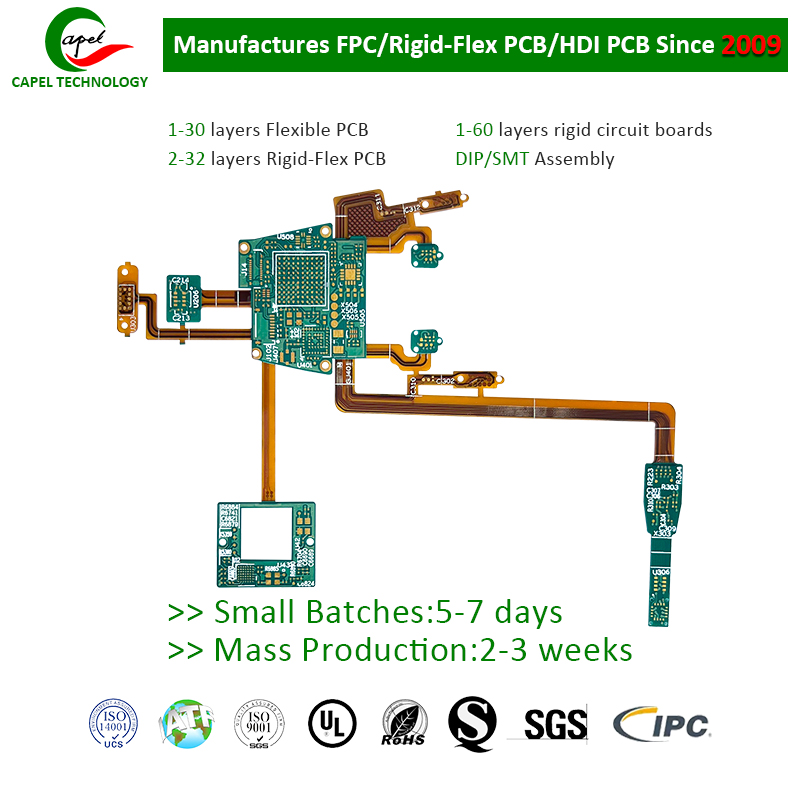Understanding the flexibility of rigid-flex PCBs is critical when optimizing performance and unlocking new design possibilities. In this blog, we’ll delve into the intricacies of this remarkable technology and explore the benefits it brings to a variety of applications.
In today’s ever-evolving electronics industry, the demand for compact and versatile technology is growing steadily. Engineers and manufacturers continue to seek innovative solutions that overcome the limitations of traditional rigid printed circuit boards (PCBs). This pursuit has led to the rise of rigid-flex PCBs, which provide the perfect balance between rigidity and flexibility.
What is the difference between rigid and flexible PCB?
Rigid-flex PCB combines the advantages of rigid and flexible substrates, embodying the best of both worlds. They consist of multiple flexible layers interconnected by rigid sections, creating a strong and adaptable circuit board. This unique structure allows engineers to design PCBs that can bend, fold, and conform to unconventional shapes without compromising functionality.
Benefits of Flexibility
1. Space optimization: One of the most significant advantages of rigid-flex PCB is its ability to optimize space utilization within electronic devices. By incorporating flexible sections, these boards can fit into narrow or irregularly shaped spaces that traditional rigid PCBs cannot fit into. This makes rigid-flex PCBs ideal for space-constrained applications such as aerospace, medical and wearable technology.
2. Enhanced reliability: Flexibility not only improves space efficiency, but also enhances the reliability and durability of electronic devices. In rigid-flex PCBs, the flexible portion acts as a stress reliever, effectively absorbing and dispersing mechanical stress caused by vibration, impact, or thermal expansion. This reduces the risk of component damage, solder joint failure and overall PCB failure.
3. Increased design freedom: Combining rigid and flexible PCB bending capabilities opens up a new realm of design possibilities. Engineers can now create curved or folded circuits that follow the contours of the device, resulting in improved ergonomics and better integration with mechanical components. This design freedom also enables the development of innovative products that were previously considered unfeasible.
4. Improve signal integrity: Signal integrity is a critical issue in electronic systems. The flexibility of rigid-flex PCBs allows engineers to carefully route signal traces along the flex, optimizing signal performance and minimizing electromagnetic interference (EMI). By reducing signal loss and EMI, you can ensure reliable communication and high-speed data transfer within electronic devices.
Design Considerations for Flexible PCBs
When designing a rigid-flex PCB, several factors should be considered to maximize its flexibility and overall performance:
1. Material selection: Choosing the right materials for rigid and flexible parts is critical. Rigid parts typically use FR4, while flexible areas use polyimide or other flexible substrates. Working with a PCB manufacturer experienced in rigid-flex design will ensure that compatible and reliable materials are selected.
2. Bend Radius: Determining the minimum acceptable bend radius is critical to preventing excessive stress on the PCB. The minimum radius that a rigid-flex PCB can safely handle must be calculated and defined based on the selected material and intended application.
3. Component placement: Proper component placement is critical to avoid stressing or damaging components during bending or flexing. Working closely with your component supplier and PCB manufacturer will ensure optimal component placement and strong bonding to withstand mechanical stress.
4. Testing and verification: Rigorous testing and verification procedures are necessary to ensure the reliability and durability of flexible PCB designs. Environmental testing and simulation tools can help identify potential issues and validate design performance under different operating conditions.
Unleashing the full potential of rigid-flex PCBs
The flexibility of rigid-flex PCBs presents incredible opportunities for product designers and engineers. This technology is creating breakthroughs across industries, from medical implants to aerospace systems and consumer electronics. However, in order to realize the full potential of flexible PCB design solutions, it is necessary to work with an experienced and trustworthy PCB manufacturer.
If you’re looking to incorporate flexible PCB technology into your next project, consider working with a PCB manufacturer that specializes in rigid-flex PCBs. Their expertise and capabilities can help you navigate the complexities of design, manufacturing, and integrating this innovative technology into your products.
In summary
The flexibility of rigid-flex PCBs is a game changer, allowing you to overcome space constraints, enhance reliability, increase design freedom, and improve signal integrity. By embracing this dynamic technology and mastering its design considerations, you can open up a world of possibilities and bring your most innovative ideas to life. Choose the right PCB manufacturer and let’s push the boundaries of the electronics world together.
Post time: Oct-11-2023
Back







